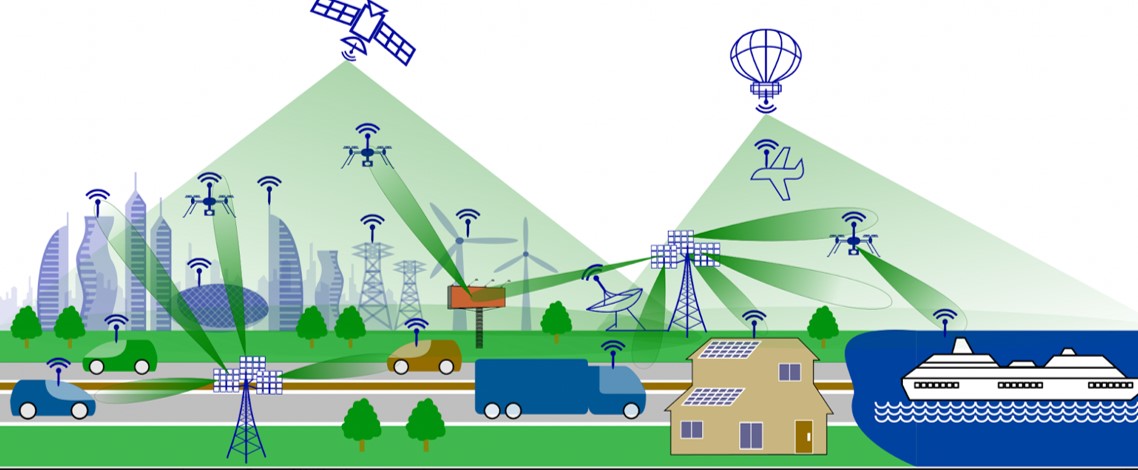What will the future of UAV cellular communications be?
A study by Giovanni Geraci and Ángel Lozano, members of the Department of Information and Communication Technologies, together with researchers from the universities of New York, North Carolina State (USA), Luxembourg, and Paris- Saclay, and Huawei Technologies.

Unmanned aerial vehicles (UAV), also commonly known as drones, are self-piloting or remotely controlled apparatuses. Drone technology has numerous applications: aerial inspection, photography, precision agriculture, traffic control, search and rescue, delivery of packages, and telecommunications, among others. Exponential growth of the global UAV industry is expected in the coming years.
A preprint study published by Giovanni Geraci and Ángel Lozano, researchers at the UPF Department of Information and Communication Technologies (DTIC), is based on the question: What will the future of UAV cellular communications be? Their study is published jointly with researchers from the universities of New York, North Carolina State (USA), Luxembourg, and Paris-Saclay, and Huawei Technologies, all members of the IEEE (Institute of Electrical and Electronics Engineers).
“We embarked on the journey from 5G to 6G and share a large amount of realistic case studies supported by original results”
While the subject of mobile communications with and from drones has advanced in recent years, many fundamental challenges remain to be addressed. “In this tutorial article, we combine academic and industrial visions for the journey from 5G to 6G and we share a large amount of realistic case studies supported by original results”, asserts Geraci, first author of the work.
The article begins with an overview of the status quo of UAV communications from an industrial standpoint. It provides updated data from 3GPP (3rd Generation Partnership Project), the organization that has been developing mobile communication standards since 1998. Specifically, the work details the new features of 5G NR (NR, New Radio), the new technology developed by 3GPP for the fifth generation of mobile networks, supporting aerial devices.
“We showcase encouraging evaluations of coverage in urban and suburban/rural settings and examine the peculiarities of direct device-to device communications in the sky”
Then, the authors showcase the potential and limitations of incorporating drones in 5G networks. For example, an array of aerials can receive and send data to and from multiple devices simultaneously.
“In particular, we showcase how such massive antenna arrays can successfully tackle cell selection and interference challenges, we showcase encouraging mmWave coverage evaluations in both urban and suburban/rural settings, and we examine the peculiarities of direct device-to device communications in the sky”, Geraci explains. Millimetre wave, or “mmWave”, is the short wavelength spectrum between 24 GHz and 100 GHz, far higher frequencies than the ones used in 4G systems, which have the capacity to deliver gigabit per second wireless services in areas with very high data demand.
Promising UAV communications for 2030
The work discusses the next generation of communications systems, listing some of the use cases planned for early 2030. The authors identify the most promising 6G enablers for communication with drones, those expected to take performance and reliability to the next level. For each of these disruptive new paradigms (non-terrestrial networks, cellfree architectures, artificial intelligence, reconfigurable intelligent surfaces, and communications at even higher than millimetre frequencies), the authors gauge the prospective benefits for UAVs and discuss the main technological hurdles that stand in their way.
Finally, the article draws the main conclusions of the state of the art in communications using drones and the most relevant findings, while identifying some key, still-to-be-solved issues concerning this promising technology.
Related work:
Giovanni Geraci, Adrian Garcia-Rodriguez, M. Mahdi Azari, Angel Lozano, Marco Mezzavilla, Symeon Chatzinotas, Yun Chen, Sundeep Rangan, Marco Di Renzo (2021) "What Will the Future of UAV Cellular Communications Be? A Flight from 5G to 6G", preprint, may. https://arxiv.org/pdf/2105.04842.pdf
